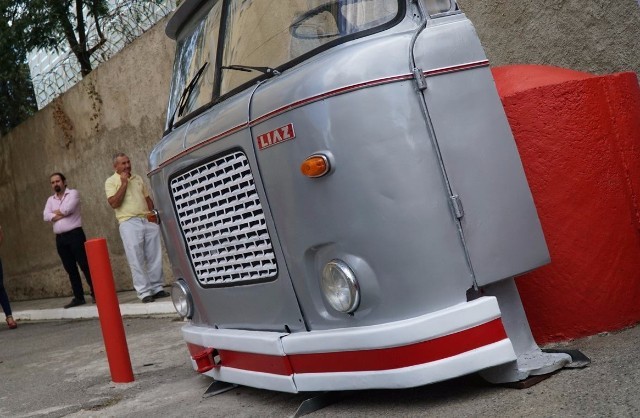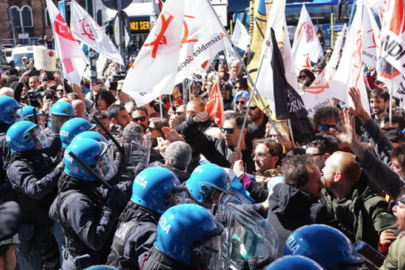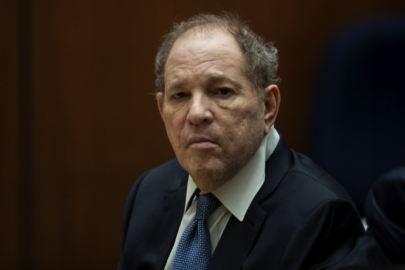On July 2, 1990, Ylli Bodinaku, took his “Liaz” truck and smashed it into the back wall of the German embassy in Tirana with his wife and to children in the passenger cab.
The crack in the wall opened the way for 3,000 people to pour into the embassy, some of them wounded by the communist police rushing after them.
“It was an unusual step, a decision that brought personal and family consequences,” says Arben Ferhati, who was then a 26-year-old typographer working in the state cartographic company, recalling his decision to enter the German embassy as well.
At the time, eight months after the fall of Berlin wall, the Communist regime in Albania remained firmly in power.
But many Albanians had had enough – and soon thousands of others had broken into other Western embassy compounds.
Some opened their doors to them freely, and refused to turn them in to the authorities.
Breaking the wall of fear
Kastriot Dervishi, the former director of Albanian Interior Ministry archives, published a document on July 2 detailing that 3,172 Albanians entered the German embassy, 809 entered the Italian embassy, 547 entered the French embassy, while the Yugoslav embassy opened its doors to six Albanians.
Some Albanians wanted only to escape political persecution. Many more, after seeing what had happened in Germany, simply wanted freedom and more opportunities.
According to Dervishi, most of these people, 2,296 of them, were workers, while 123 had a university degree.
An overwhelming majority of them, 3,905, were from Tirana, but thousands came from other parts of Albania when they heard the news.
Not all of them reached safety within embassy walls. After the first break-ins, the regime deployed police around the buildings to prevent people from getting inside them. Many were wounded making the attempt.
Xhemil Beharaj, a journalist living in southwestern town of Fier, was 25 and on vacation at a beach when he learned that Western embassies were taking in Albanians who wanted to escape.
“I arrived in Tirana the next day by train without the police discovering my aim, al though after two days of roaming the city I felt desperate, because the police were monitoring all the walls surrounding the embassies,” he said.
Fatmir Merkoci, a distinguished anti-communist activist, told BIRN that the first nights of July were chaotic in Tirana.
While the former secret police, the Sigurimi, hunted down people who tried to reach the embassies, the regime also started persecuting the families of those who had fled.
“Horrible propaganda against those who were leaving and repression of their families started. Some parents were forced to deny their children, fearing further punishment,” he recalled.
After 10 nights spent in embassies in difficult conditions, and with the regime pressuring the diplomats to hand them back to the authorities, the United Nations stepped in, ordering passports to be provided for all those within the embassies and negotiating with the government on their safe exit from Albania.
On July 13, they were sent to Durres, a port from where they reached Italy. Later, they were sent on to various chosen countries.
“The event shamed the Albanian regime in the eyes of the whole world,” Dervishi wrote on Facebook, recalling what happened 27 years ago.
A few months later, in December, the regime began to collapse, after massive student protests demanding democratic pluralism took place.
Containing the urge of Albanians to leave turned out to be mission impossible. After failing to reach any of the embassies in July 1990, journalist Xhemil Beharaj left Albania less than a year later.
“My wish to go abroad was finally realised in March 1991, in Greece,” he told BIRN.
Hundreds of thousands would follow him out of the country in the years to come. The latest exodus was in 2015.
Referring to Albanian Foreign ministry data, around 1.4 million Albanians now live abroad, the overwhelming majority of whom left in the last two decades immediately after the fall of communism.
Around 75 per cent of Albanians leaving the country went to Greece, while 500,000 others live in Italy. In recent years, migration has been directed toward more economic developed countries like the United States, Canada and the UK.
In 2015, a fresh exodus started when around 50,000 Albanians, mainly women and children, left the country to seek economic asylum in Germany. The German authorities refused almost every request, and have since Albania listed as a safe country of origin.
Remembrance at the wall
On July 3, architects Gjergj Islami and Ana Pekmezi and artist Eljan Tanini unveiled an installation on the wall of the German embassy in Tirana – the actual shape of Ylli Bodinaku’s famous “Liaz” truck that will permanently remain in the embassy wall.
“I will never forget my old truck and how it changed the life of my family,” he told Shekulli newspaper on Monday.
Islami told BIRN that he and his friends and collaborators in the project lived near the embassy block in Tirana and were always intrigued by the history of the area.
“The symbol of a truck destroying a wall in order for the passengers to reach another world was strong, so we thought to turn it into an art installation,” Islami said.
However, the group says the mark to be left on the German embassy wall is just the beginning of a bigger project, named “Muri” [“The Wall”].
Even today the main block of embassies in Tirana is surrounded by a high wall that separates it from the neighborhood. The wall was erected in Communist times, when the area could not be crossed by ordinary people.
The wall remains, even though citizens can now pass freely through the embassies block – albeit monitored by the security guards.
“The absurdity of its presence is a signal of the barriers of the past that still shape our life. We aim to use it to regenerate the urban space by creating an open-air museum,” Islami said.
They propose painting the wall in red, to highlight its presence, while several art installations will enrich the public space around it. “We need to make every effort to ensure the young do not forget history,” Islami concluded.
































